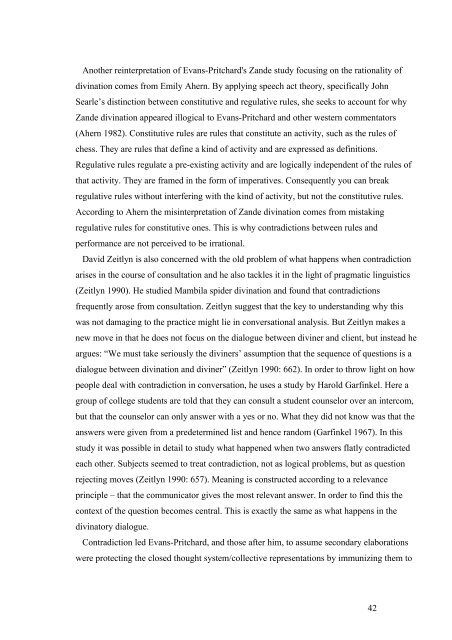The dissemination of divination in roman republican times
The dissemination of divination in roman republican times
The dissemination of divination in roman republican times
You also want an ePaper? Increase the reach of your titles
YUMPU automatically turns print PDFs into web optimized ePapers that Google loves.
Another re<strong>in</strong>terpretation <strong>of</strong> Evans-Pritchard's Zande study focus<strong>in</strong>g on the rationality <strong>of</strong><br />
<strong>div<strong>in</strong>ation</strong> comes from Emily Ahern. By apply<strong>in</strong>g speech act theory, specifically John<br />
Searle’s dist<strong>in</strong>ction between constitutive and regulative rules, she seeks to account for why<br />
Zande <strong>div<strong>in</strong>ation</strong> appeared illogical to Evans-Pritchard and other western commentators<br />
(Ahern 1982). Constitutive rules are rules that constitute an activity, such as the rules <strong>of</strong><br />
chess. <strong>The</strong>y are rules that def<strong>in</strong>e a k<strong>in</strong>d <strong>of</strong> activity and are expressed as def<strong>in</strong>itions.<br />
Regulative rules regulate a pre-exist<strong>in</strong>g activity and are logically <strong>in</strong>dependent <strong>of</strong> the rules <strong>of</strong><br />
that activity. <strong>The</strong>y are framed <strong>in</strong> the form <strong>of</strong> imperatives. Consequently you can break<br />
regulative rules without <strong>in</strong>terfer<strong>in</strong>g with the k<strong>in</strong>d <strong>of</strong> activity, but not the constitutive rules.<br />
Accord<strong>in</strong>g to Ahern the mis<strong>in</strong>terpretation <strong>of</strong> Zande <strong>div<strong>in</strong>ation</strong> comes from mistak<strong>in</strong>g<br />
regulative rules for constitutive ones. This is why contradictions between rules and<br />
performance are not perceived to be irrational.<br />
David Zeitlyn is also concerned with the old problem <strong>of</strong> what happens when contradiction<br />
arises <strong>in</strong> the course <strong>of</strong> consultation and he also tackles it <strong>in</strong> the light <strong>of</strong> pragmatic l<strong>in</strong>guistics<br />
(Zeitlyn 1990). He studied Mambila spider <strong>div<strong>in</strong>ation</strong> and found that contradictions<br />
frequently arose from consultation. Zeitlyn suggest that the key to understand<strong>in</strong>g why this<br />
was not damag<strong>in</strong>g to the practice might lie <strong>in</strong> conversational analysis. But Zeitlyn makes a<br />
new move <strong>in</strong> that he does not focus on the dialogue between div<strong>in</strong>er and client, but <strong>in</strong>stead he<br />
argues: “We must take seriously the div<strong>in</strong>ers’ assumption that the sequence <strong>of</strong> questions is a<br />
dialogue between <strong>div<strong>in</strong>ation</strong> and div<strong>in</strong>er” (Zeitlyn 1990: 662). In order to throw light on how<br />
people deal with contradiction <strong>in</strong> conversation, he uses a study by Harold Garf<strong>in</strong>kel. Here a<br />
group <strong>of</strong> college students are told that they can consult a student counselor over an <strong>in</strong>tercom,<br />
but that the counselor can only answer with a yes or no. What they did not know was that the<br />
answers were given from a predeterm<strong>in</strong>ed list and hence random (Garf<strong>in</strong>kel 1967). In this<br />
study it was possible <strong>in</strong> detail to study what happened when two answers flatly contradicted<br />
each other. Subjects seemed to treat contradiction, not as logical problems, but as question<br />
reject<strong>in</strong>g moves (Zeitlyn 1990: 657). Mean<strong>in</strong>g is constructed accord<strong>in</strong>g to a relevance<br />
pr<strong>in</strong>ciple – that the communicator gives the most relevant answer. In order to f<strong>in</strong>d this the<br />
context <strong>of</strong> the question becomes central. This is exactly the same as what happens <strong>in</strong> the<br />
div<strong>in</strong>atory dialogue.<br />
Contradiction led Evans-Pritchard, and those after him, to assume secondary elaborations<br />
were protect<strong>in</strong>g the closed thought system/collective representations by immuniz<strong>in</strong>g them to<br />
42


